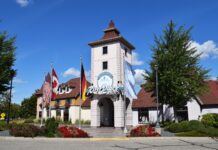
The plan to replace the outdated I-375 freeway with an urban boulevard designed to spur economic development has hit a snag.
Michigan Department of Transportation officials said Monday the department is pausing the I-375 Reconnecting Communities Project in order to “re-evaluate” the project.
The plan calls for replacing the sunken I-375 freeway in downtown Detroit that runs between Interstate 75 and Jefferson Avenue with a six-lane boulevard at city street level and a four-lane boulevard between Jefferson Avenue and Atwater Street. The existing I-75/I-375 interchange would also be rebuilt with a smaller footprint.
Due to rising costs, longevity of the final project and roadway, and public concern over design elements, MDOT will delay the start of construction to continue reviewing design alternatives, ensuring the final product meets the needs of the public and key stakeholders, department officials said in a press release Monday.
“We have one opportunity to get this project right,” said State Transportation Director Bradley C. Wieferich. “I-375 has been open for more than 60 years, and we expect the new I-375, whatever design it may be, to be in place much longer. Getting this right for the community and our stakeholders, while remaining good stewards of tax dollars, will remain our priority.”
As MDOT pauses to reevaluate design alternatives and prepare additional public engagement, continued focus on the road and bridge conditions of the I-375 corridor will remain a priority. Several bridges along the corridor have exceeded their service lives and will require replacement soon to remain safe and open to the public.
The plan originally came with a $300 million pricetag; some estimates now have reportedly risen as high as some $500 million.
But a statement from MDOT Monday said the project was being re-evaluated “as a whole” and officials were “working to determine our next steps.”
Back in the fall, city officials called the I-375 project a “transformational project” to convert the downtown interstate spur and the Gratiot Connector to a surface boulevard. The conversion, they said at the time, “will address the inherent safety concerns with maintenance of the highway and bridges, the current interchange, and accessibility into surrounding communities and the Riverfront.”
In a posting to the city’s website, officials said the project “requires a greater understanding of the impacts to surrounding communities,” including what they called historic harm of past urban renewal efforts that removed a great center of black culture, commerce, and people; impacts of construction on surrounding communities and businesses and how to mitigate them; and the need to maintain safe connections and access for Detroiters and our visitors.
I-375 cut off the adjacent neighborhood from downtown and led to the demolition of Hastings Street, the last part of the Black Bottom neighborhood. Removing the expressway and replacing it with a boulevard will reconnect city streets in the area. While it won’t bring back Hastings Street, it offers opportunities to honor the area’s history, promote equitable development, enhance cultural spaces, and improve mobility.
“As development has pushed east from downtown and west from Lafayette Park, the barrier that I-375 represents in our city has become even more apparent,” Detroit Mayor Mike Duggan said last year. ”It was Black residents and Black businesses that were hurt when Black Bottom was wiped out and they were displaced for the construction of this freeway.”
The Michigan Department of Transportation did an environmental review process after securing a Finding of No Significant Impact (FONSI), which initially allowed the project to advance.
“We must build up our state’s infrastructure with equity at the core,” Michigan Gov. Gretchen Whitmer said in a release. “While we cannot change the past, we must work harder to build a more just future, and that starts with listening to and engaging with the community, and taking deliberate steps to get this done right.”







